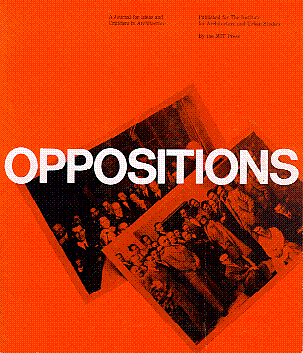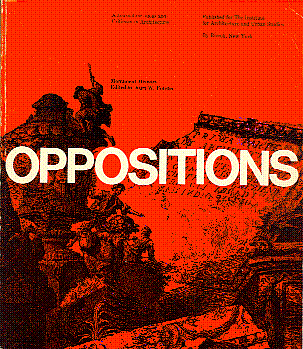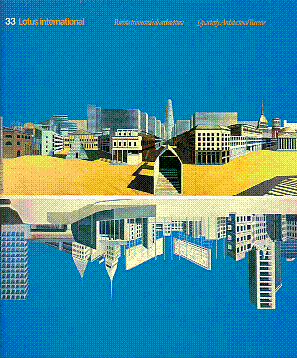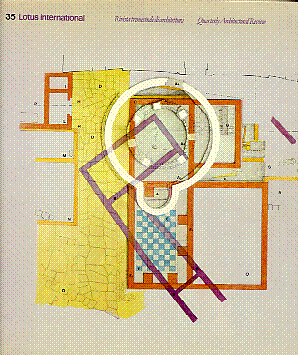Cooper & Pratt House 2246
Mayor's House 2269
Eugene J. Johnson, What Remains of Man--Aldo Rossi's Modena Cemetery (Journal of the Society of Architectural Historians, March 1982).
Alfred Frazer on, Das Gartenstadion in der Villa Hadriana (Journal of the Society of Architectural Historians, March 1982).
Pierre de la Ruffinière du Prey on, A.D. Profile 23: Neo-Classicism (Journal of the Society of Architectural Historians, March 1982).
| |

Peter Eisenman, et al, Oppositions 24 (Cambridge, MA: The MIT Press, 1982).
Contents
Christian Bonnefoi:
Louis Kahn and Minimalism
Leon Krier:
Vorwärts, Kameraden, Wir Müssen Zurück
Joan Ockman:
The Most Interesting Form of Life
Elmar Holenstein:
Excursus: Monofunctionalism in Architecture Between the Wars (Le Corbusier and the Bauhaus)
Werner Oechslin:
Critical Note to Elmar Holenstein's Criticism of Le Corbusier's Monofunctionalism
Bernhard Schneider:
Non-functionalist Functionalism
Giorgio Ciucci:
The Invention of the Modern Movement
Kenneth Frampton:
Casabella and the Reading of History
Alan Colquhoun:
Review of Stuart Wrede, The Architecture of Gunnar Asplund
| |

Peter Eisenman, et al, Oppositions 25 (Cambridge, MA: The MIT Press, 1982).
Contents
Kurt W. Forster:
Monument/Memory and the Mortality of Architecture
Alois Riegl:
The Modern Cult of Monuments: Its Character and it Origin
Anthony Vidler:
The "Art" of History: Monumental Aesthetics from Winckelmann to Quatremère de Quincy
Ignasi de Solà-Morales:
Toward a Modern Museum: From Riegl to Giedion
Alan Colquhoun:
Thoughts on Riegl
André Corboz:
Walks Around Horses
O. K. Werckmeister:
Walter Benjamin, Paul Klee, and the Angel of History
William H. Gass:
Monumentality/Mentality
| |

Pierluigi Nicolin, 33 Lotus International (Milan: Gruppo Editoriale Electa, 1982).
Contents
Imitating the city
Marco De Michelis:
The myth of the phoenix
John Hejduk:
Berlin Masque
Giorgio Grassi:
Single building
Mairice Culot:
A stimulating return to the past
Pierluigi Nicolin:
Innenhof & Innengarten
Emilio Battisti:
A block in three sections
Emilio Battisti:
The architect Livio Vacchini
Rafael Moneo:
The Logroño Town Hall
Daniele Vitale:
Rafael Moneo, Architect
C.O.P.R.A.T.:
State housing in Mantua
Francesco Venezia:
Transfer of a fragment
Diana Agrest, Mario Gandelsonas:
New York, Historical District
Vittorio Magnago Lampugnani:
Building in a lineal series
Demetri Porphyrios:
Classicism is not a style
Piero Derossi:
Density and rerefaction
Piero Derossi:
New relations
Anthony Vidler:
The hut and the body
Ignasi de Solà Morales:
From memory to abstraction
Christian Borngräber:
Georgy Gol'c
| |

Pierluigi Nicolin, 35 Lotus International (Milan: Gruppo Editoriale Electa, 1982).
Contents
The museum of architecture
Hubert Damisch:
The museum device
O.M. Ungers:
Planimetric transformations
Pierluigi Nicolin:
Paris: The Museum d'Orsay
Dominique Poulot:
Architectural models
Stephen Bann:
Historical text and historical object
Gae Aulenti, Italo Rota:
King's court
Alessandra Ponte:
Thinking machines
Franco Rella:
The Vertigo of the Mélange
John Summerson:
Union of the arts
Licisco Magagnato:
Scarpa's museum
Ignasi de Solà Morales:
Support, Surface
Adolfo Natalini/Superstudio with David Palterer:
Access to the Wailing Wall
Barbara Weiss:
American museums: three examples
James Stirling::
Museum expansion
Mary MacLeod:
Private museums and public virtue
Francesco Dal Co:
The house of dreams and memories
|